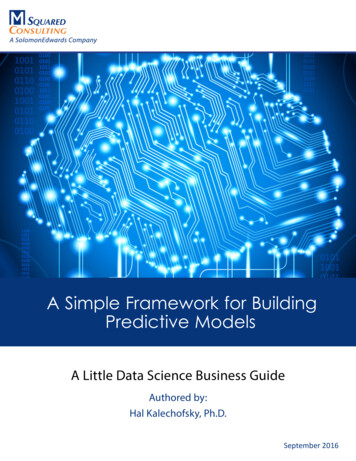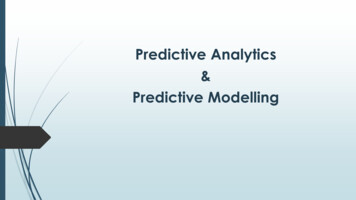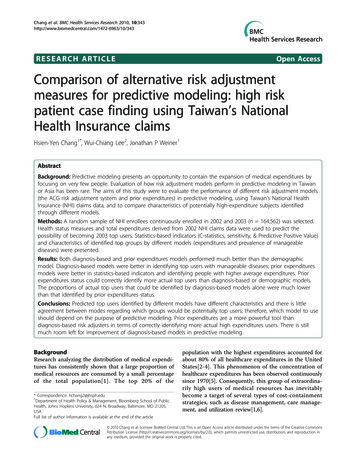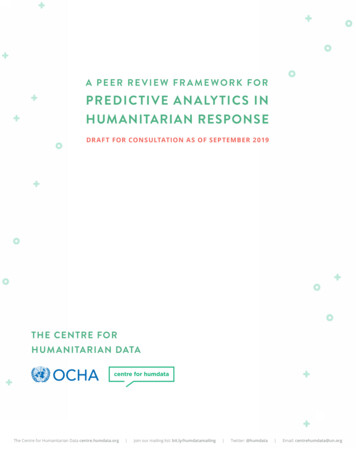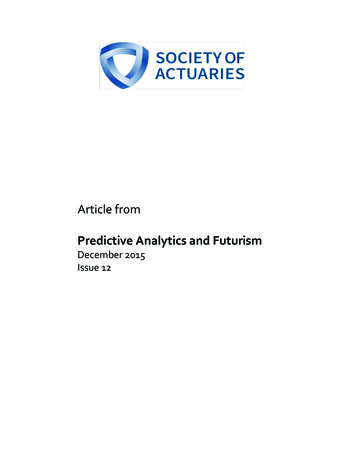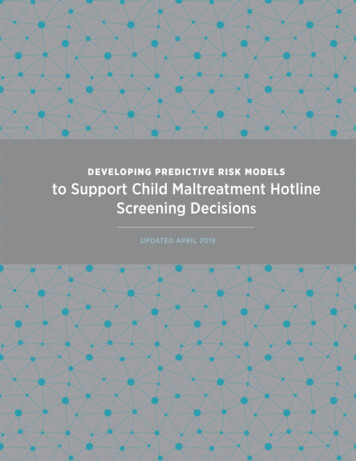
Transcription
DEVELO P ING PR E DICT I V E R I S K M ODE LSto Support Child Maltreatment HotlineScreening DecisionsUPDATED APRIL 2019
Developing Predictive Risk Models to Support Child Maltreatment Hotline Screening Decisions April 20191In August 2016, the Allegheny County Department of HumanServices (DHS) implemented the Allegheny Family ScreeningTool (AFST), a predictive risk modeling tool designed to improvechild welfare call screening decisions. The AFST was the resultof a two-year process of exploration about how existing datacould be used more effectively to improve decision-making atthe time of a child welfare referral. More information can befound here about the AFST.The process began in 2014 with a Request for Proposals and selection of a team from AucklandUniversity of Technology led by Rhema Vaithianathan and including Emily Putnam-Hornsteinfrom University of Southern California, Irene de Haan from the University of Auckland, MarianneBitler from University of California – Irvine and Tim Maloney and Nan Jiang from AucklandUniversity of Technology. Input was solicited throughout the exploration and developmentprocess and used to inform the final product. Prior to implementation, the model was subjectedto an ethical review by Tim Dare of the University of Auckland and Eileen Gambrill of the Universityof California-Berkeley. Upon the conclusion of this review, to which DHS prepared a response,the developers proceeded with implementation.Concurrent with this process was the issuance of a second Request for Proposals, at the end of2015, for an impact and process evaluation of the model. Awarded the contracts were StanfordUniversity (impact evaluation) and Hornby Zeller Associates (process evaluation). Both theprocess evaluation and the impact evaluation have been completed.The first version of the AFST (V1) was utilized from August 2016 through November 2018.In December 2018, an improved model, V2, was implemented and included changes to thetarget outcome, data sources, and visualization of the tool.Development, implementation and evaluation of the AFST were made possible by a public/private funding partnership that included generous support from the Richard King MellonFoundation, Casey Family Programs and the Human Services Integration Fund, a collaborativefunding pool of local foundations under the administrative direction of The Pittsburgh Foundation.
Developing Predictive Risk Models to Support Child Maltreatment Hotline Screening Decisions March 2019This publication includes eight documents:SECTION 1 (APRIL 2017)Developing Predictive Risk Models to Support Child Maltreatment Hotline Screening Decisions:Allegheny County Methodology and Implementationprepared by Rhema Vaithianathan, PhD; Nan Jiang, PhD; Tim Maloney, PhD; Parma Nand, PhD;and Emily Putnam-Hornstein, PhDSECTION 2 (APRIL 2017)Ethical Analysis: Predictive Risk Models at Call Screening for Allegheny Countyby Tim Dare and Eileen GambrillSECTION 3 (APRIL 2017)Response to Ethical Analysisby the Allegheny County Department of Human ServicesSECTION 4 (JANUARY 2018)Allegheny County Predictive Risk Modeling Tool Implementation: Process Evaluationby Hornby Zeller Associates, Inc.SECTION 5 (APRIL 2019)Impact Evaluation Summaryby the Allegheny County Department of Human ServicesSECTION 6 (APRIL 2019)Impact Evaluation of a Predictive Risk Modeling Tool for Allegheny County’s Child Welfare Officeby Jeremy D. Goldhaber-Fiebert, PhD and Lea Prince, PhDSECTION 7 (APRIL 2019)Allegheny Family Screening Tool: Methodology, Version 2prepared by Rhema Vaithianathan, PhD; Emily Kulick; Emily Putnam-Hornstein, PhD;and Diana Benavides PradoSECTION 8 (APRIL 2019)Frequently-Asked Questionsby the Allegheny County Department of Human ServicesEach document may be viewed independently, but together they provide an overview ofthe process and thinking that went into the development and implementation of the AFSTand the conclusions and recommendations of the independent evaluators.2
SECTION 1: Developing Predictive Risk Models to Support Child Maltreatment Hotline Screening Decisions: March 2019Developing Predictive Models toSupport Child Maltreatment HotlineScreening Decisions: AlleghenyCounty Methodology andImplementationApril 2017Rhema Vait hianathan, PhDEmily Putnam-Hornstein , PhDNan Jiang, PhDParma Nand, PhDTim Malon ey, PhD1
SECTION 1: Developing Predictive Risk Models to Support Child Maltreatment Hotline Screening Decisions: March 2019ContentsBackground . 4Current Practice . 5Calls to the Child Protection Hotline . 5County Screening of Maltreatment Allegations . 6Re-referrals and Placements of Children and Victims . 7Latent Risk vs. Observed Risk. 7Determining the Target Outcome of A PRM . 8Data . 11Methodology for Placement and Re-Referral Model . 13Alternative Methods Considered . 14Race . 15Model Performance . 15Placement Model . 15Re-referral Model . 17Concerns over Policy Changes in 2015 . 18External Validation of the Model . 19External Validation: Hospitalisation . 19External Validation: Critical Events . 23Comparison to Structured Decision Making and Rule-based/Threshold Approaches . 24Implementation of the Risk Score . 26Mandatory Screen-In . 27Impact of Race as a Predictor . 29Using the Model in Practice . 30Technical Implementation . 31Training . 32Next Steps: Six Month Rebuild and Adding a Random Forest Model. 33Conclusion . 34Appendix: Variables Used in the Allegheny Child Welfare Predictive Risk Model . 36Appendix: Hospital Injury Classifications. 43References. 4422
SECTION 1: Developing Predictive Risk Models to Support Child Maltreatment Hotline Screening Decisions: March 2019List of FiguresFigure 1-6: Proportion of Selected Hospital Injury Events for Children Referred to Allegheny County by MaximumPlacement Scores . 20Figure 7: Stata output from Estimate of Model 1 . 23Figure 8: Screen Shots of the Family Risk Score . 27Figure 9: Referral Progression Process. 30Figure 10: Technical Implementation of the Screening Tool . 31List of TablesTable 1: GPS Referral Dispositions (Between April 1, 2010 and May 4, 2016) . 6Table 2: Re-referral and Placement Rates Within 2 Years (victims and children in referrals between March 1, 2010and April 29, 2014) . 7Table 3: Area under ROC curve of Placement PRM (validation sample only, probit and boosted regressions, includingrace variables) . 16Table 4: Area under ROC curve of Placement PRM (validation sample only, probit regressions, excluding racevariables). 16Table 5: Area under ROC curve of Re-referral PRM (validation sample only) . 17Table 6: Area under ROC curve of Re-referral PRM (validation sample only, probit regressions, excluding racevariables). 17Table 7: Mean-Maximum Referral Score by year (All referrals) . 18Table 8: Placement Score of Admitted Children who were also referred to Child Welfare . 22Table 9: Comparison of SDM with Allegheny County Model. 24Table 10: Threshold Model vs. PRM for identifying “high risk” referral . 26Table 11: Screening Score Groups and Act 33 . 28Table 12: Screening Score Groups and Outcomes (all sample of referrals, no race model). . 28Table 13: Screening Score Groups and Outcomes (all sample of referrals, With race model). . 29Table 14: Comparison of those who were placed and flagged as mandatory screen-in risk group . 3433
SECTION 1: Developing Predictive Risk Models to Support Child Maltreatment Hotline Screening Decisions: March 2019BACKGROUNDPredictive Risk Modelling (PRM) uses routinely collected administrative data to model future adverse outcomes thatmight be prevented through a more strategic delivery of services. PRM has been used previously in health and hospitalsettings (Panattoni, Vaithianathan, Ashton, & Lewis, 2011; Billings, Blunt, Steventon, Georghiou, Lewis, & Bardsley,2012) and has been suggested as a potentially useful tool that could be translated into child protection settings(Vaithianathan, Maloney, Putnam-Hornstein, & Jiang, 2013). In the context of child protective services, PRM toolscan be used to help child protection staff make better initial screening and service decisions for children who havebeen named in reports of alleged abuse or neglect. Specifically, PRM can be deployed at the point that a referral isreceived by a child protection hotline. These referrals are typically made when someone in the community (e.g., aneighbor or a mandated professional such as a teacher) is concerned that a child has been the victim of abuse orneglect.In 2014, Allegheny County’s Department of Human Services issued a Request for Proposals focused on thedevelopment and implementation of tools that would enhance use of the County’s integrated data system. Specifically,the County sought proposals that would: (1) improve the ability to make efficient and consistent data-driven servicedecisions based on County records, (2) ensure public sector resources were being equitably directed to the County’smost vulnerable clients, and (3) promote improvements in the overall health, safety and well-being of Countyresidents. A consortium of researchers from Auckland University of Technology (AUT: Vaithianathan, Jiang,Maloney), the University of Southern California (USC: Putnam-Hornstein), the University of California at Berkeley(UCB: Gambrill), and the University of Auckland (UA: Dare) submitted a proposal outlining a scope of work focusedon the use of PRM to support decisions made at the time a child has been reported for alleged abuse or neglect. Thisteam was awarded the contract in the Fall of 2014 and commenced work in close concert with the Allegheny Countyteam.In mid-2015, it was decided that the most promising, ethical, and readily implemented use of PRM within theAllegheny County child protection context was one in which a model would be deployed at the time an allegation ofmaltreatment was received at the hotline. The objective was to develop a decision aid to support hotline screeners indetermining whether a maltreatment referral is of sufficient concern to warrant an in-person investigation. The presentreport describes the methodology used to develop and implement this model, the Allegheny Screening Tool.It should be noted that while in some settings machines have been used to replace decisions that were previously madeby humans, this is not the case for the Allegheny Family Screening Tool. It was never intended or suggested that thealgorithm would replace human decision-making. Rather, that the model should help to inform, train and improve thedecisions made by the child protection staff.44
SECTION 1: Developing Predictive Risk Models to Support Child Maltreatment Hotline Screening Decisions: March 2019CURRENT PRACTICEAllegheny County’s Department of Human Services is unique in the United States: it has an integrated client servicerecord and data management system. This means that the County’s child protection hotline staff are already able toaccess and use historical and cross-sector administrative data (e.g., child protective services, mental health services,drug and alcohol services, homeless services) related to individuals associated with a report of child abuse or neglect.Although this information is critical to assessing child risk and safety concerns, it is challenging for County staff toefficiently access, review, and make meaning of all available records. Beyond the time required to scrutinize data forevery individual associated with a given referral (e.g., child victim, siblings, biological parents, alleged perpetrator,other adults living at the address where the incident occurred), the County has no means of ensuring that availableinformation is consistently used or weighted by staff when making hotline screening decisions. As such, for example,recent paternal criminal justice involvement that surfaces in the context of one child’s referral may factor into adecision to investigate a report of maltreatment, while for another child that same information could be completelyignored.To help the reader understand the context in which the new PRM tool will be implemented, a short summary ofcurrent screening practice has been provided below.Calls to the Child Protection HotlineA referral for suspected child abuse or neglect is received by Allegheny County either via the Pennsylvania StateHotline (i.e., ChildLine) or directly through the County’s local hotline. Allegations made to the State Hotline areemailed to the County’s local hotline staff. Allegations can be classified as falling under the State’s: (1) “childprotective service” (CPS) (23 Pa.C.S. § 6303) or (2) “general protective services” (GPS) (23 Pa.C.S. § 6334) statutes.Designation under CPS means that the allegation includes abuse or severe neglect and automatically meets thestatutory threshold for it to be screened-in for investigation. For the 2015 year, we find that 17% of all reports inAllegheny County were designated as allegations falling under CPS statutes.Child maltreatment referrals, whether defined as CPS or GPS, typically identify a variety of individuals. Theseindividuals typically include the alleged child victim(s), the biological mother and father of the alleged victim, theperpetrator (who may or may not be a biological parent), other related and unrelated children in the home, and otheradults who may also be residing at the address.55
SECTION 1: Developing Predictive Risk Models to Support Child Maltreatment Hotline Screening Decisions: March 2019County Screening of Maltreatment AllegationsIf the maltreatment allegation is classified as falling under CPS statutes based on the information reported, then localCounty screening staff have no further decision-making authority and a child maltreatment investigation must beginwithin 24 hours. If, however, an allegation is classified as GPS, then County hotline staff (i.e., screener andsupervisor) have the joint discretion to respond by: (1) screening-out the allegation without any further evaluation orassessment (if there are no children age 6 or younger in the household1), (2) conducting a field screen of themaltreatment allegation in order to evaluate the safety and well-being of the child and determine whether a fullinvestigation is warranted, or (3) conducting a formal investigation of the maltreatment allegation to determine ifmaltreatment has occurred and there is a potential for future harm to the child. As such, the screening-in of amaltreatment allegation is synonymous with conducting a formal “investigation.” Meanwhile, following the fieldscreen, a decision is made to screen-in or screen-out the referral.For GPS reports that are screened in for investigation (either at the outset or after a field screen has been conducted),the report is transferred from the County’s hotline office and assigned to one of five regional child welfare offices(typically on the basis of the report’s geographic origins) or remains with the intake office so that a formalinvestigation can be conducted.To provide a sense of the distribution of maltreatment reports, and the subsequent screening decisions that were made,in Table 1 we present historical data for the period from April 1, 2010 through May 4, 2016 (only for GPS). The tableillustrates that a majority of GPS reports (52%) are screened out.Table 1: GPS Referral Dispositions (Between April 1, 2010 and May 4, 2016)TotalNumbers inEach Category% of TotalReferralsTotal Screened In55,51348%Total Screened Out (1)60,92352%Total Referrals (with call screening reason given)116,436100%1Allegheny County has had a rule that any GPS report involving a child age 6 or younger cannot be screened out without firsthaving a field screen. This decision reflects recognition that the vast majority of critical and fatal maltreatment events occur tochildren in this age group. Upon implementation of this tool, the field screen policy has been modified. Field screens are nowconducted when (a) reports involve children age 3 and younger who are impacted by the allegations, (b) when a report is thefourth referral for a family within two years and there has not been a previous investigation, (c) when a report involves childrenwho are in cyber/home school, or (d) whenever call screening staff would like more information about the allegations, children, orfamily. Notes to table: (1) Screen out reasons include, but are not limited to, information does not meet the legal definition ofchild maltreatment and no risk of maltreatment or safety concerns noted after a field screen was conducted. Table excludes thosethat are CPS and therefore automatically screened in.66
SECTION 1: Developing Predictive Risk Models to Support Child Maltreatment Hotline Screening Decisions: March 2019Re-referrals and Placements of Children and VictimsTable 2 shows the re-referral and placement rates of children2 in a referral, based on their initial disposition. Thesecond row shows that among all children and victims included in a referral (between March 1, 2010 and April 29,2014) that was opened for investigation, approximately 1 in 2 experienced a follow-up allegation of maltreatment androughly 1 in 8 were subsequently placed within 2 years of the first referral.As expected, those children who were screened out had a higher chance of being re-referred than those who werescreened in (53% vs. 45%). By contrast, those who were initially screened in have a higher chance of being placedwithin 2 years than those who were initially screened out (13% vs 5%).Table 2: Re-referral and Placement Rates Within 2 Years (victims and children in referrals between March 1,2010 and April 29, 2014)Re-referred within 2years (%)Placed within 2years (%)Screened In45%13%Screened Out (1)53%5%Average49%9%(1) Screen out reasons include, but are not limited to, information does not meet the legal definition of child maltreatment and norisk of maltreatment or safety concerns noted after a field screen was conducted. Table excludes those that are CPS and thereforeautomatically screened in.LATENT RISK VS. OBSERVED RISKAt hotline screening, a child is assessed for evidence that abuse or neglect has occurred and the probability that thechild will experience future harm if no services are provided and/or no action is taken. If the probability of futureharm is elevated above a given (admittedly normative and context-specific) threshold, then the County may bejustified in acting to serve the family and protect the child in either a voluntary or involuntary manner.Theoretically, developing a predictive model for this underlying “latent” risk of future harm would require a researchdata set where no actions (or “interventions”) had been taken following the initial maltreatment referral (e.g.,investigations, services, placements in foster care). We would then follow these children for two years and see which2Discussions with Allegheny County staff suggest that the role of “victim” does not always identify the only victim in a GPSreferral. Often, the victims of GPS referrals include all children (e.g., all children are impacted by parental substance abuse orhomelessness), but not all children are called “victim child” in a referral consistently. Call screening staff, however, are makingdeterminations about the risk and safety of all children involved in a call. Therefore, it was determined that the modelling wouldassess the risk of each child in the referral (whether denoted as victim or child). Therefore, in this document we use the termchildren to denote those cases where we are discussing anyone in a referral that is denoted a child as well as a victim.77
SECTION 1: Developing Predictive Risk Models to Support Child Maltreatment Hotline Screening Decisions: March 2019children went on to experience future abuse, neglect, or other forms of maltreatment and harm. For example, whenbuilding a PRM tool for hospital readmission risk, it is typical to use a sample of patients who do not access any kindof post-discharge services so that one can try and identify risk factors that contribute to readmission.Such a research dataset, however, is never available in the child protection context. At initial hotline screening,decisions are made that influence the child’s future trajectory and future risk of harm. Therefore, careful considerationmust be given to modelling the outcome that is being predicted in order not to predict outcomes that are simply reproducing past decisions made by hotline screening staff.The challenges related to this should not be understated. In the available historical data for Allegheny County, childrenare not left alone. Indeed, half of children are screened in for investigation at the time of the initial maltreatmentreferral used for modelling purposes. Their subsequent course of events is therefore dictated by a series of decisionsand actions taken by the child protection system. The risk factors that can then be identified are a combination of therisk factors that reflect latent risk and factors that capture hotline screening decisions. To address this, predictionsmust be developed conditional on these historical decisions that influence the outcomes observed.DETERMINING THE TARGET OUTCOME OF A PRMWhile there is not universal agreement on the degree to which the current clinical assessment at point of referral isfocused on the longer-term risk of adverse events versus assessing the current crisis of alleged abuse or neglect, theresearch team and Allegheny County chose to design a model to predict long arc risk. This decision was made becausethe logic of predictive risk modelling from the health literature is that it is a way of supplementing clinical decisionmaking. By offering clinicians a risk score that stratifies that the patient is at long term risk of, for example,readmission to hospital, the clinicians could be alerted to looking at the wider context of patient’s situation thansimply the current medical crisis that brought the patient to the attention of the clinician. Similarly, targeting the PRMon long arc-risk complements the role of the screening staff who are focused on the information about the allegationcontained in the referral.The predictive risk model is designed to support hotline screening staff to determine which reports of maltreatmentinvolve children who are at greatest risk of: (1) future abuse and neglect, (2) future involvement with child protectiveservices, and/or (3) future critical incidents (i.e., near-fatalities and fatalities). Information concerning the statisticalprobability that a given child will experience one or more of these future events is valuable as these are arguably88
SECTION 1: Developing Predictive Risk Models to Support Child Maltreatment Hotline Screening Decisions: March 2019outcomes that all child protection systems seek to prevent.3 As such, this information can be used to establishstatistical thresholds that help prioritize and sort reports of alleged maltreatment into those in which the action ofcarrying out a full investigation seems particularly warranted and those in which screening out may be justified.Before determining how to operationalize, predict, and condition these future maltreatment and child protectionoutcomes, however, the inherent trade-offs that are made at the hotline screening decision must be identified. Inmedical screening parlance, it is important to consider the trade-off between sensitivity (the proportion of patients witha disease who are correctly screened positive) and specificity (the proportion of patients without the disease who arecorrectly screened negative) in the specific and nuanced contexts of child protection.While in the case of clinical diagnosis the ultimate outcome being screened for (i.e., disease or no disease) is clear, inthe case of maltreatment allegations screened by child protection hotlines, the concept of “service need” or latent riskis poorly developed. Therefore, we need to take a more nuanced view of what a “good” initial hotline screeningdecision is.An ideal system would screen out children who are at low risk of a future event and therefore have less need for earlyintensive services. One way of assessing lower need is to consider whether children would be re-referred if they areiniti
by the Allegheny County Department of Human Services SECTION 6 (APRIL 2019) Impact Evaluation of a Predictive Risk Modeling Tool for Allegheny County's Child Welfare Office by Jeremy D. Goldhaber-Fiebert, PhD and Lea Prince, PhD SECTION 7 (APRIL 2019) Allegheny Family Screening Tool: Methodology, Version 2

